Sleep Apnea is a breathing disorder that occurs during sleep, mainly characterized by repeated collapse of the upper respiratory tract, leading to apnea or shallow breathing. This condition can have long-term negative effects on an individual's sleep quality and health.
Taipei sleep apnea recommendations-Fenghua United ClinicWe will use a professional perspective and share a wealth of cases to tell you about the major and minor issues of sleep apnea.
What is sleep apnea?
sleep apnea, also called apnea, means that during sleep,A condition in which repeated obstruction of the upper respiratory tract occurs, causing the patient's breathing to stop intermittently or completely..
This condition is usually accompanied by obvious snoring and repeated awakenings during the night, which seriously affects the sleep quality and health of the person next to the pillow and the individual.
According to clinical observations, most patients suffer fromObesity causes narrowing of the upper airway or lack of muscle toneresulting in respiratory arrest syndrome.
Additionally, enlarged tonsils or other structural problems may contribute to this condition.
Medically, apnea can be divided into 3 main types:
- blocking type: The most common type, accounting for approximately 901 TP3T cases, is usually caused by obstruction of soft tissue in the throat.
- central type: Inability to control respiratory movements properly due to neurological problems.
- hybrid: It has characteristics of both blocking type and central type.
Next, these three types of sleep apnea will be introduced in detail.
repeatedlyrespiratory arrestIt's taking away your health!
Find out now how Fung Wah United ClinicOrthognathic surgery, completely solve the deadly threats hidden in sleep!
3 major types of sleep apnea
obstructive sleep apnea
Obstructive Sleep Apnea (OSA) is the most common type, accounting for approximately 90% of all cases.
The cause is mostly due to excessive soft tissue hypertrophy in the throat, curved nasal septum or turbinate hypertrophy, or tonsil or tongue base hypertrophy.
The main characteristic is that during sleep,The upper respiratory tract is blocked due to collapse of soft tissue, resulting in apnea or shallow breathing.. Sufferers often snore loudly and wake up frequently during the night.
This condition can lead to a drop in blood oxygen levels, which can lead to a range of health problems, including daytime sleepiness, difficulty concentrating, and an increased risk of cardiovascular disease.
There are two main treatment methods. One is to apply positive pressure through a continuous positive airway pressure (CPAP) to prevent the collapse of the upper airway. The other is to expand the airway through orthognathic surgery to solve the problem of respiratory cessation.
In addition, losing weight, quitting smoking and drinking, and sleeping on your side can also slightly improve the condition.
central sleep apnea
Central Sleep Apnea (CSA) is relatively rare and its main cause is related to the nervous system.
The brain is unable to send normal breathing signals, causing patients to temporarily stop breathing during sleep.
Central causes may includeBrain injury, stroke, or other neurological disease.
Because central sleep apnea is treated differently than obstructive sleep apnea, treatment usually targets the underlying cause of the problem, such as using appropriate medications or using methods such as neurostimulation.
mixed sleep apnea
Mixed sleep apnea has both obstructive and central features.
Patients may experience obstruction of the upper airway and abnormal breathing signals from the brain during sleep.
This situation often requires a combination of both types of treatments to achieve the best results.
In summary, understanding the characteristics of these three types of apnea can help patients and physicians work together to develop a truly effective treatment plan.
Snoring loudlyIt could be a fatal signal!
Fenghua United ClinicOrthognathic surgery, professionally solve obstructive and mixed sleep apnea, allowing you to return to peaceful sleep!
Understanding the sleep apnea index
The Apnea-Hypopnea Index (AHI) is used toAssess sleep apnea severityimportant indicators.
It measures theThe total number of apnea and hypopnea events experienced by the patient per hour of sleep..
The following are AHI values and their meaning:
| Severity | numerical value | Data interpretation |
|---|---|---|
| normal | AHI < 5 | Breathing stops or weakens less than 5 times per hour |
| Mild | AHI 5-15 | 5 to 15 cessations or weakening of breathing per hour |
| Moderate | AHI 15-30 | 15 to 30 respiratory arrests or weakenings per hour |
| Severe | AHI > 30 | More than 30 interrupted or weakened breaths per hour |
Clinically, normal healthy adults should have less than 5 AHIs. If the AHI exceeds 5 times, sleep apnea can be diagnosed, and the severity of the condition will be further evaluated based on its value and a corresponding treatment plan will be formulated.
Below is one of the cases at Fenghua United Clinic: Are cases replaceable?
A 39-year-old male patient was referred by an orthodontist because he was always drowsy during the day. Sleep testing found that hisThe AHI index is 22.5, and the lowest blood oxygen concentration is 89%.
Computerized tomography showed that his upper and lower jaw bones were underdeveloped and compressed backwards, causing a narrowed airway.
We design for himBi-jaw orthognathic surgery, rotated the occlusal plane counterclockwise, pulled his middle and lower face bones forward, and adjusted his distorted nasal septum and shortened the lower nose clips on both sides in the same operation.
As can be seen in the picture below, his airway has been significantly broadened, and the problem of chin retraction has also been significantly improved.
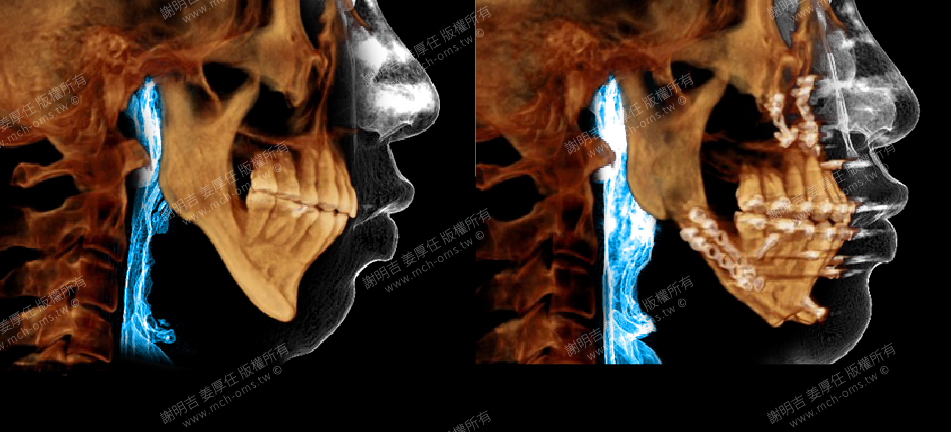
He had another sleep test 3 months after the operation and hisAHI dropped significantly from 22.5 to 5.1, and the minimum blood oxygen concentration increased to 93%.
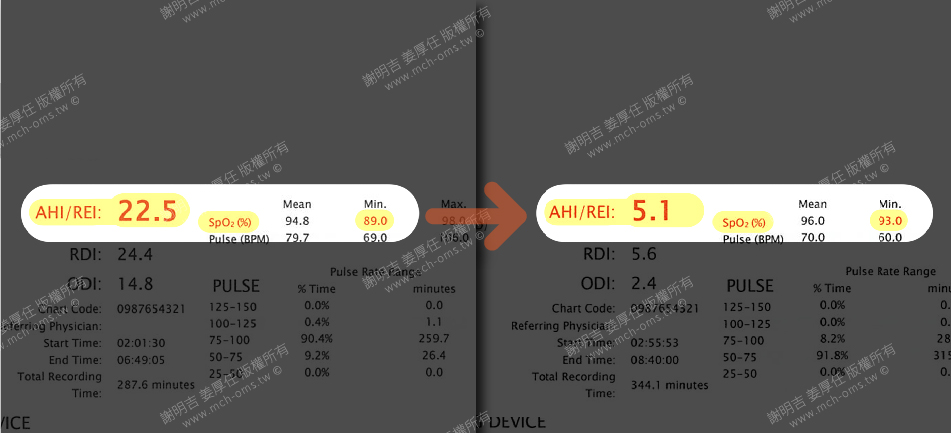
What are the potential risks of developing sleep apnea syndrome?
If sleep apnea syndrome is not treated, possible health risks include:
- cardiovascular disease: Long-term hypoxia may lead to high blood pressure, arrhythmia and other problems.
- metabolic problems: Increases risk of diabetes and metabolic syndrome.
- mental health effects: May cause anxiety, depression and other emotional problems.
- Accident risk: Daytime sleepiness can lead to accidents while driving or working.
From the above hazards, we can know that sleep apnea not only affects your sleep quality, but also causes various negative harms to your health and daily life. The sooner you treat it, the more control you can have back in your life!
Sleep apnea is quietly destroying your health!
Fenghua United ClinicOrthognathic surgery, to help you stay away from complications of respiratory arrest such as cardiovascular crisis, and regain your health and peace of mind. Consult now!
The most common groups with sleep apnea
The main groups that are prone to sleep apnea fall into the following 7 categories. The characteristics and background of these groups are described in detail below.
1. Male
Men are a high-risk group for sleep apnea. Studies have shown thatThe incidence rate in men is approximately 2 to 8 times that in women.
This may be related toIt is related to male physiological structure and hormones. Men usually have more neck fat., which increases the risk of upper respiratory tract obstruction.
2. Middle-aged and elderly people
Age is also an important factor in developing sleep apnea.
This symptom usually occurs inMore common in people over 40 years old, as age increases,The tone and strength of the throat muscles may be reduced, making the upper airway more likely to collapse.
Among the elderly, the incidence of sleep apnea can be as high as 10%.
3. Obese people
According to epidemiological studies, approximately 1/7 adults (approximately 1 billion people) worldwide suffer from obstructive sleep apnea (OSA), and obesity is considered to be one of the main risk factors.
As obesity rates rise globally, the incidence of OSA has also shown an alarming growth trend.
According to statistics, about 60% patients with sleep apnea are overweight. For every 10% increase in weight, the chance of suffering from sleep apnea will increase six times.
In a study involving 161 obese patients with a BMI ≥ 30 kg/m², more than 50% patients were diagnosed with sleep apnea, of which 25% patients had severe cases. In addition, the prevalence of apnea in obese patients with BMI ≥ 40 kg/m² is as high as 98%. These data highlight the direct link between body mass index (BMI) and sleep apnea.
4. Postmenopausal women
Postmenopausal women are also at high risk. Women are hormonally protected until menopause and have a relatively low chance of developing sleep apnea.
However, after menopause, this protective effect disappears due to hormonal changes, leaving them at increased risk.
5. Neck circumference is too large
Individuals with excessive neck circumference are also one of the high-risk groups. Increased neck circumference is often associated with fat accumulation, which can further lead to obstruction of the upper airway.
Medical research points out thatNeck circumference over 16 inches for men and over 15 inches for women, the risk of which is significantly increased.
6. Structural abnormalities of the upper respiratory tract
Certain anatomical abnormalities, e.g.Curved nasal diaphragm, enlarged turbinates, enlarged tonsils, excessively long uvula, and retruded mandibleetc., may also lead to upper airway obstruction and narrowing of the airway, thereby causing sleep apnea.
In addition, enlargement of the base of the tongue increases the risk of airway obstruction.
7. Living habits
Bad lifestyle habits such as smoking, drinking alcohol and excessive use of sleeping pills or sedatives can also increase the risk of sleep apnea.
Not only do these behaviors affect respiratory health, they may also cause muscles to relax excessively, making the airway more susceptible to collapse.
Who are youHigh-risk groups for sleep apnea?
The above problems are threatening your life! Fenghua United Clinic’s professional consultation and orthognathic surgery can help you get rid of potential crises!
Common symptoms of sleep apnea
Common symptoms during the day
- Lethargy: Patients often feel tired during the day, doze off easily, and are unable to stay awake.
- Headache: I often feel a headache when I wake up in the morning, which may be related to lack of oxygen at night.
- lack of concentration: Unable to concentrate on work or study for a long time, affecting daily life and work efficiency.
- memory loss: Frequent forgetting things, memory loss.
Common symptoms at night
- Light sleep or insomnia: Patients tend to wake up midway and have poor sleep quality. They often dream or sleepwalk or talk in their sleep.
- Frequent urination: Need to go to the toilet multiple times at night, affecting the continuity of sleep.
- severe snoring: Loud and irregular snoring may affect your partner’s sleep.
- apnea: Brief pauses in breathing during sleep, which often cause the patient to wake up during the night.
sleep apnea complications
- cardiovascular disease: Sleep apnea is highly correlated with a variety of cardiovascular diseases. Studies have shown that these patientsHigh blood pressure, heart failure, coronary artery diseaserisk is significantly increased.
- Stroke: Sleep apnea patientsThe chance of stroke can increase by 3 to 8 times. This is because hypoxia caused by nocturnal apnea triggers increased sympathetic nervous system activity, which affects heart function and blood pressure.
- diabetes: Sleep apnea is associated with metabolic syndrome, which includesObesity, diabetes and insulin resistanceetc. questions. Patients with respiratory arrest are more likely to have metabolic abnormalities and have difficulty controlling diabetes.
- cognitive dysfunction: Long-term sleep deprivation and hypoxia can affect brain function, leading to inattention, memory loss and other cognitive dysfunction. Many patients willEmotional problems such as anxiety and depression may occur, and may accelerate the development of Alzheimer's disease.
- sexual dysfunction: Sleep apnea may also cause reduced libido and sexual dysfunction. This is related to nighttime hypoxia and daytime sleepiness, which affects the patient's overall quality of life.
Fenghua United Clinic reminds you that if you have the above symptoms for a long time, please seek medical treatment as soon as possible to avoid delaying the best golden treatment time!
Sleep apnea syndrome self-diagnosis method
If the general public wants to self-test for apnea, they can judge by asking the following questions:
- Do you often wake up and fall asleep at night?
- Do you snore a lot at night?
- Do you often get up to go to the toilet at night?
- Do you experience drowsiness or lack of energy during the day?
- Is it easy to get a headache when you wake up in the morning?
- Do you tend to feel dry mouth when you wake up in the morning?
- Are you easily irritable or depressed?
- Will you experience major mood swings or even sudden personality changes in the near future?
- Is memory failing?
- Low libido?
If more than 3 of them match your condition, you may have sleep apnea syndrome, and it is recommended to seek medical treatment as soon as possible.
Benefits of Treating Sleep Apnea
Treating sleep apnea early can bring many benefits, including:
- Improve sleep quality and increase energy levels during the day.
- Reduces the risk of cardiovascular disease and other complications.
- Improve the quality of life and restore previous work and social abilities.
Which department should I see for sleep apnea?
If you suspect that you have sleep apnea, the following departments are recommended:
- Oral and maxillofacial surgery: For patients with congenital craniofacial structural abnormalities and chin retrusion resulting in narrow airways, oral surgeons can provide orthognathic surgery to widen the airways to solve the problem of sleep apnea.
- Otolaryngology: Many causes of sleep apnea are related to the structure of the upper respiratory tract, such as tonsil hypertrophy, nasal septum curvature and other problems.
- Thoracic Medicine: Focusing on diseases of the respiratory system, pulmonologists can evaluate patients’ lung health and provide appropriate treatment recommendations.
- Neurology: For central sleep apnea caused by neurological problems, a neurologist can perform a more in-depth examination and diagnosis.
- Department of Family Medicine: The family physician can serve as the outpatient clinic for initial evaluation and make referrals to other specialties based on the patient's specific circumstances.
- Sleep Medicine Center: Many hospitals have specialized sleep medicine centers, which integrate multiple specialists, including otolaryngology, thoracic medicine, neurology, etc., to provide comprehensive diagnostic and treatment services.
These departments can effectively diagnose and treat different types of sleep apnea. Patients can choose the appropriate treatment department according to their own symptoms.
doubt that I havesleep apnea?
Fenghua United ClinicOne-stop orthognathic surgery service, comprehensively solve breathing disorders and let you sleep peacefully!
5 major examination items for sleep apnea syndrome
The examination items for sleep apnea mainly include a series of physiological monitoring, which can help doctors accurately diagnose the condition.
The following are common inspection items:
1. Polysomnography (PSG)
This is a standard item for diagnosing sleep apnea. The following physiological indicators will be monitored during the examination:
- Brain waves (EEG): Record brain activity and assess sleep stages.
- Eye movement graph (EOG): Monitors eye movements to help determine rapid eye movement sleep (REM) stage.
- Electromyography (EMG): Measures jaw and leg muscle activity to assess muscle tone.
- Electrocardiogram (ECG): Monitors the electrical activity of the heart and assesses heart health.
- blood oxygen saturation: Measures the oxygen concentration in the blood through a sensor on your fingertip or earlobe.
- respiratory flow: Monitor the airflow between the mouth and nose, and record the frequency and intensity of breathing.
- Thoracic and abdominal breathing activities: Measures chest and abdominal movement to evaluate breathing patterns.
- Snoring frequency: Record the frequency and intensity of snoring.
2. Multiple Sleep Latency Test (MSLT)
This is a daytime test primarily used to assess daytime sleepiness. Subjects took multiple short sleep episodes during the day to measure sleep onset time and sleep quality.
3. Sleep quality screening at your own expense
This at-home check-up is often suitable for people with symptoms such as snoring or daytime sleepiness. Patients perform self-tests at home using simple devices and receive initial assessment results.
4. Positive pressure breathing pressure test (PAP titration)
This test is usually performed at night and is used to adjust the optimal pressure of the continuous positive airway pressure (CPAP) machine to ensure that the patient is getting enough oxygen during sleep.
5. Physical and mental status assessment
Before conducting the above examination, the doctor may ask for a basic health status assessment, including the collection of basic information such as height, weight, blood pressure, and a questionnaire on sleep quality and snoring.
These examination items can comprehensively evaluate the patient's sleep status and breathing conditions and help doctors formulate appropriate treatment plans.
How is sleep apnea treated?
Common treatments
- lose weight: For obese patients, it helps improve their condition.
- Positive pressure respirator: Continuously provides airflow through the device to prevent respiratory tract collapse.
- braces device: For mild patients, it can reduce snoring and improve breathing.
- Orthognathic surgery: For structural problems, surgery to expand the airway can be considered, which is an effective long-term solution.
Advantages of orthognathic surgery
Orthognathic surgery (Maxillomandibular Advancement, MMA) has many advantages for treating obstructive sleep apnea, especially in improving upper airway patency and overall sleep quality.
- Improve upper respiratory tract structure: Orthognathic surgery moves the upper and lower jaw forward,Expanded airway space behind tongue base and soft palate, thereby reducing or eliminating obstruction of the respiratory tract.
- Improve treatment response rate: According to clinical research, for patients with severe maxillary and mandibular retrusion and malocclusion,The response rate of orthognathic surgery as first-line treatment can reach 100%. Even in some obese patients, the response rate can be increased to 78% when combined with other surgeries (such as soft palate or tongue surgery).
- Effective for a long time: The results of orthognathic surgery are usually permanent. Many patients who undergo surgery continue to maintain good sleep quality after surgery, and their blood oxygen saturation and heart rate and other physiological indicators return to normal ranges.
Is it difficult to maintain a positive pressure respirator??
Orthognathic surgery is the first choice for curing sleep apnea! Fenghua United Clinic can help you improve your suffocation crisis. Consult now!
Can apnea syndrome improve on its own?
Changing lifestyle and eating habits, such as losing weight, not smoking, not drinking, sleeping on your side, etc., can alleviate some sleep apnea syndrome, but professional medical intervention is still needed to eradicate the disease.
Apnea can be truly and effectively improved through medical treatments such as orthognathic surgery or positive pressure respirators.
Sleep apnea syndrome treatment case sharing
Fung Wah United Clinic has extensive experience in treating sleep apnea syndrome. Through orthognathic surgery, many patients have regained their lost quality of life.
The 28-year-old man had a history of severe snoring, light sleep, and daytime sleepiness. After sleep testing, it was found that hisAHI index 45, lowest blood oxygen concentration dropped to 76%, these data showed that he had severe sleep apnea.
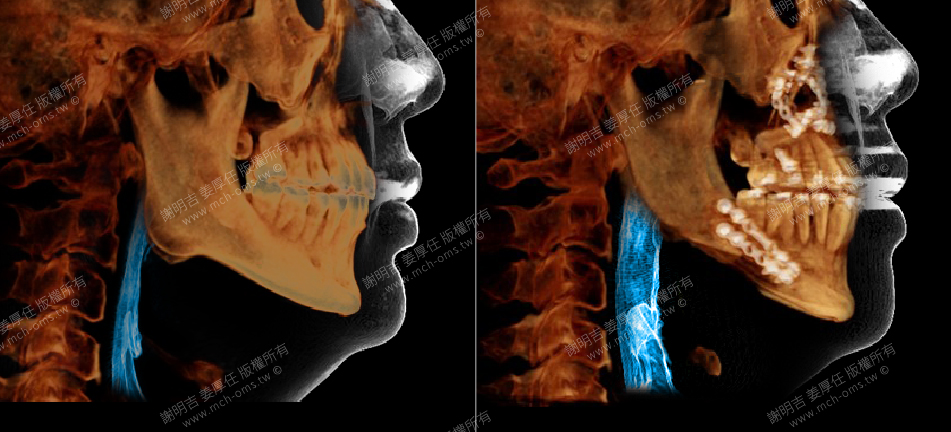
Through his CT scan, it was found that his upper and lower jaw bones were underdeveloped, which compressed the airway.
We performed mandibular advancement (MMA) with both jaws rotating counterclockwise.
After airway lift (orthognathic surgery), hisThe symptoms of sleep apnea were relieved, the AHI index dropped to 0.4, and the lowest blood oxygen concentration increased to 92%. He no longer has problems with snoring, restless sleep, or daytime sleepiness.
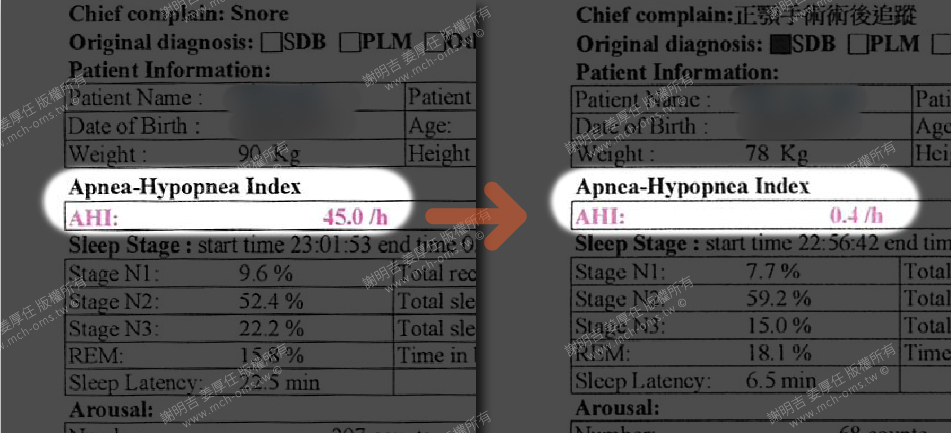
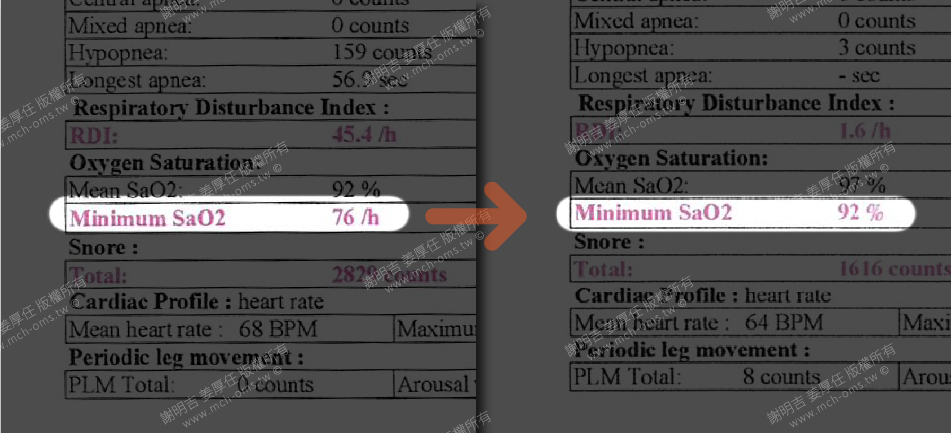
MoreSuccess Stories…










